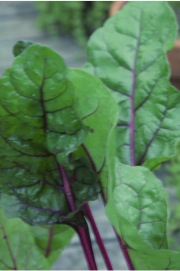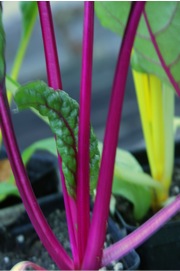
 Photos by Malgorzata Florkowska
Photos by Malgorzata Florkowska- Soil Preparation, Planting, Culture and Fertilization
- Harvesting, Storing and Using
- Problems
- Varieties
Swiss chard is a member of the beet family. It is a great source of vitamins C, K and A, and it also contains omega-3 fatty acids. Swiss chard is easy to grow and it tolerates mild freezes. It is grown as a summer green, and both leaves and stems are edible. Leaves can be eaten raw in salads or cooked like spinach. Stems can be cooked in a variety of dishes. Swiss chard is very low in calories (19 calories per 100 grams of raw leaves), which makes it an important food in a low-cholesterol, low-fat diet.
Soil Preparation, Planting, Culture and Fertilization
Swiss chard requires eight to 10 hours of sunshine per day, so be sure to choose a sunny location in your garden. Prepare the bed by loosening the soil to a depth of 10 inches. Discard weeds, rocks and roots, and break up big clods of earth. Add 3 to 4 inches of organic amendment such as compost, pine bark or aged animal manure. Mix the amendment thoroughly into the garden soil. For proper fertilization, soil testing through your local county Extension office is always recommended. In the absence of a soil test, apply a complete garden fertilizer such as 10-10-10 at a rate of 1 1/2 pounds per 100 square feet of garden. Sow the seeds as soon as the soil is workable. In rows, sow the seeds 1 inch apart, with 12 to 15 inches between the rows. In raised beds, sow the rows 8 to 10 inches apart. In both cases cover the seeds with 1/2 inch of soil. Thin the seedlings 4 to 6 inches apart as soon as they are large enough to be pulled out.
For an earlier crop, start seedlings indoors. Cover the seeds with 1/2 inch of potting soil and keep them in a warm place with good light. Supplemental light may be required to promote sturdy growth and prevent plants from becoming leggy. Set up lights 6 inches above the plants, and keep them on for about 14 hours a day. Water the soil with a fine mist to keep the plants moist. Harden the plants off before transplanting them into a garden. This can be done by leaving them outside for two to three days, being sure to bring them back inside each night. On the fourth day leave them outside for 24 hours.
To limit weed growth and to conserve water, mulch the plants with weed-free grass clippings, straw or wood chips. Be sure grass clippings were not treated with an herbicide. For Swiss chard to grow properly and develop tender leaves, apply approximately 1 inch of water per week. If you have to water with overhead irrigation, do so in the early morning so that the foliage will have a chance to dry before nighttime.
Harvesting, Storing and Using
Swiss chard leaves should be harvested when they are young and tender, at about 12 inches long. They are usually ready for harvest four to six weeks after planting. Pick the largest outside leaves. Continue to harvest until the plants bolt and go to flower. If you cannot eat all the leaves as fast as they grow, cut them off and return them to the compost pile.
Problems
Swiss chard is resistant to most plant diseases, but insects such as leaf miners can be a problem. These insects lay eggs under the surface of the leaves. When the eggs hatch, the larvae bore their way between leaf tissues, causing damage. Provide a pest barrier for the plants by covering them with cheesecloth or commercial row covers.
Swiss chard is not deer tolerant. Deer eat it mostly in the fall when other food sources are not available. Repellants or deer-proof fencing may be necessary to protect the crop.
Varieties
| Mixed | |
| Bright Lights | 40 days to maturity. Stems are red, white, orange, pink, violet and yellow mixed. |
| Red (Rainbow) | |
| Burgundy | 40 days to maturity. Dark green leaves with burgundy stems. |
| Rhubarb | 40 days to maturity. Red stems; deep green leaves with red veins. |
| Ruby | 45 days to maturity. Ruby-red stems, reddish-green leaves, red veins. |
| White (Rainbow) | |
| Fordhook | 42 days to maturity. Dark green, savoyed leaves, light green stalks. |
| Lucullus | 40 days to maturity. Dark green leaves, white stalks. |
| Winter King | 40 days to maturity. Dig in fall; keep cool and moist for winter harvest indoors. |
Status and Revision History
Published on Feb 26, 2014
Published with Full Review on Mar 28, 2017
Published with Full Review on Jul 13, 2022


























































